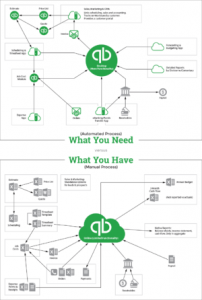| Feature | QBO | Pro | Prem | Commentary |
| Estimates (i.e. Job Costing) | ✔ | ✔✔ | ✔✔ | Initial estimate of a given job or project. Can be linked to invoices and progress billing. Depending on Edition, can include costs and run Estimate to Actual reports. |
| Class Tracking | “Plus” only | ✔ | ✔ | Additional functionality to break down figures by eg. Divisions. |
Job Costing is relevant to businesses who deliver value in projects: Professional Services (Lawyers, Architects, and let us not forget Accountants) and Contractors (Builders, Plumbers, Electricians) are two common examples. If your business is not a job shop, then please feel free to read this for general interest.
Class Tracking allows you to break down figures in a bit more detail. Classes give you a bit more flexibility to your reporting generally, and to your Estimates in particular.
The most obvious example is by client type (residential, commercial, government). Labour costs are another example. You might only have two types of labour (on-site and admin), but it would be more meaningful for you if you could track how many hours (and dollars) your on-site employees are spending between welding, joining, and fitting. You can easily set up two labour accounts in Quickbooks, but it would be an admin headache if you had to reconcile each on-site employee’s pay back to the welding, joining, and fitting GL codes.
If you’re a job shop, it’s critical that you accurately track all your costs against the relevant jobs. It’s also important that you do so Efficiently and Effectively. Sadly, this isn’t always the case.
Many companies create their detailed quotes in one Excel workbook, manually key the information across to a formal Quote, create bills in (yet another, series of) Excel workbooks, and only then record the billed amount in Quickbooks. Job costs are recorded as AP items in Quickbooks, but aren’t always coded against the job. This is slow, time-consuming, and most likely doesn’t produce all the information you need to make good decisions.
Alternatively: Quickbooks has a fairly sophisticated built-in job costing system. If you use it properly, you can integrate all the following tasks:
- Load or enter your Estimates (revenues and costs) directly into Quickbooks;
- Convert the Estimate to a formal Quote (without the costs) to be sent to your client;
- Bill your customer from the Estimate screen;
- Record the purchased costs AND labour hours against the Estimate;
- Run budget-to-actual reports to show how your project is performing.
This is collecting information on a cost-effective basis, and using it to make good decisions – a massive competitive advantage.
That said, getting the best of it requires a bit of set up and background work. There is a solid amount of up-front work required, but the payback will be huge.
We welcome your Comments! Please also feel free to Contact us, either via email or using our website.

